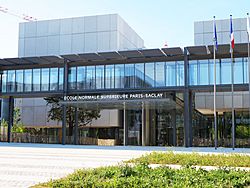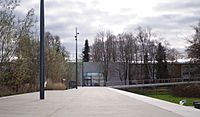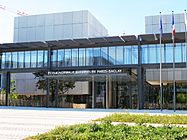Paris-Saclay University facts for kids
|
Université Paris-Saclay
|
|
 |
|
|
Former name
|
University of Paris Sud XI Paris Faculty of Sciences in Orsay |
|---|---|
| Type | Public research university |
| Established | c. 1150 University of Paris 1956 University of Paris in Orsay 1971 Paris-Sud University 2014 As a community 2019 Replaces Paris-Sud University |
| Chancellor | Christophe Kerrero (Chancellor of the universities of Paris) |
| President | Estelle Iacona |
|
Academic staff
|
10,500 |
| Students | 60,000 |
| Undergraduates | 5,400 |
| Postgraduates | 23,300 |
| 6,000 | |
| Location |
,
,
48°42′42″N 2°10′17″E / 48.7117343°N 2.1712888°E |
| Campus | Campus of Saclay (Orsay - Gif), Campus of Versailles, Campus of Évry , Campus of Saint-Quentin-en-Yvelines, Campus of Paris |
Paris-Saclay University (French: Université Paris-Saclay) is a combined technological research institute and public research university based in Paris, France. Paris-Saclay was established in 2019 after the merger of four technical grandes écoles, as well as several technological institutes, engineering schools, and research facilities; giving it fifteen constituent colleges with over 48.000 students combined.
With the merger, the french government has explicitly voiced their wish to rival top American and Chinese technological research institutes, such as the MIT and Tsinghua. The university has over 275 laboratories in particle physics, nuclear physics, astrophysics, atomic physics and molecular physics, condensed matter physics, theoretical physics, electronics, nanoscience and nanotechnology. It is part of the larger Paris-Saclay cluster, which is a research-intensive academic campus encompassing Paris-Saclay University, the Polytechnic Institute of Paris, combined with a business cluster for high-technology corporations. Paris-Saclay notably also includes the Institut des Hautes Études Scientifiques, where many contributions to the development of modern mathematics have been made, amongst them modern algebraic geometry and catastrophe theory.
As of 2021, 11 Fields Medalists and 3 Nobel Prize winners have been affiliated with the university and its associated research institutes.
Contents
History
In 2019, the Paris-Saclay University succeeded to University of Paris-Sud (Paris XI) founded in 1971, which itself succeeded to University of Paris founded c. 1150.
After World War II, the rapid growth of nuclear physics and chemistry meant that research needed more and more powerful accelerators, which required large areas. The University of Paris, the École Normale Supérieure and the Collège de France looked for space in the south of Paris near Orsay. Later some of the teaching activity of the Faculty of Sciences in Paris was transferred to Orsay in 1956 at the request of Irène Joliot-Curie and Frédéric Joliot-Curie. The rapid increase of students led to the independence of the Orsay Center on March 1, 1965. It became the University of Paris-Sud (Paris XI) in 1971.
The Paris-Saclay University was established in 2015 as a universities community (ComUE) and in 2019 as a university, with the aim to become a top-ranking, research-focused French university. In order to be recognized as an entity of sufficient size and quality, the university regroups some of the top grandes écoles in France with public universities under a single campus on the Saclay plateau. Each member institution will remain independent but share a significant portion of existing and newly invested resources. This follows a model similar to the one adopted by University of Oxford and Cambridge, where each constituent college keeps its independence while being grouped under a 'university'.
The University System's first academic year started in September 2015.
According to Dominique Vernay, chairman of the foundation developing Paris-Saclay, the university aims at a top-ten position in the Academic Ranking of World Universities (ARWU), but "the first goal is to be the top university in continental Europe".
In January 2020, it replaced University of Paris-Sud (Paris XI) and in 2025, Université de Versailles-Saint-Quentin-en-Yvelines (UVSQ) and Université d'Évry-Val-d'Essonne (UEVE) will merge with it as well.
Organisation
The Paris-Saclay University consists of five faculties in Sciences, Medicine, Pharmacy, Law-Economics-Management, and Sports Sciences; an Engineering school; three technical institutes specialised in scientific and technical subjects in Cachan, Orsay, and Sceaux; and an undergraduate university school.
The University also brings together four grandes écoles: CentraleSupélec, AgroParisTech, ENS Paris-Saclay and the Institut d'Optique Graduate School, with two associate institutions: Versailles Saint-Quentin-en-Yvelines University (UVSQ) and University of Évry Val d'Essonne (UEVE).
It combines resources from the following French universities and grandes écoles, as well as partial resources from various research organizations and the Systematic Paris-Region cluster:
Initially, the community of universities also included five other grandes écoles: École Polytechnique, Télécom Paris, Telecom SudParis, ENSTA Paris and ENSAE Paris. However, due to differences in University set-up, these five grandes écoles created their own separate university Polytechnic Institute of Paris. This was announced by French President Emmanuel Macron during a speech in Paris-Saclay. Both of these clusters plan to co-operate and they engage in organization of several master's degrees with the Paris-Saclay University.
Faculties and Institutes
| Name | Foundation | Academic degree | Field | Students | Campus |
|---|---|---|---|---|---|
| Paris-Saclay Undergraduate University School | 2019 | Undergraduate | Law, Economics and Science | 13,000 | Paris-Saclay, Guyancourt, Sceaux, Évry-Courcouronnes |
| Paris-Saclay Faculty of Sciences | 1956 and 1971 | Undergraduate and postgraduate | Science | 10,000 | Paris-Saclay |
| Paris-Saclay Faculty of Law, Economics and Management | 1968 | Law and economics | 6,000 | Sceaux | |
| Paris-Saclay Faculty of Pharmacy | 1972 | Medicine | 3,500 | Paris-Saclay | |
| Paris-Saclay Medical School | 1971 | 3,400 | Le Kremlin-Bicêtre, Paris-Saclay | ||
| Paris-Saclay Faculty of Sports Sciences | 1985 | Science | 1,500 | Paris-Saclay | |
| Polytech Paris-Saclay | 2004 | Engineering | 820 | Paris-Saclay | |
| Orsay University Institute of Technology | 1971 | Science and engineering | 440 | Paris-Saclay | |
| Sceaux University Institute of Technology | 1970 | 1,500 | Sceaux | ||
| Cachan University Institute of Technology | 1971 | 1,000 | Cachan |
Grandes Écoles and graduate schools
| Name | Foundation | Field | Students | Campus |
|---|---|---|---|---|
| AgroParisTech | 1826 | Life sciences | 2,420 | Paris-Saclay |
| CentraleSupélec | 2015 | Science and Engineering | 5,350 | Paris-Saclay, Rennes, Metz |
| ENS Paris-Saclay | 1892 | Science | 1,360 | Paris-Saclay |
| Institut d'optique Graduate School | 1917 | Optics | 440 | Paris-Saclay |
| Paris-Saclay Graduate School of Law | 2019 | Law | Guyancourt, Sceaux | |
| Paris-Saclay Graduate School of Physics | 2019 | Physics | Paris-Saclay, Versailles, Évry-Courcouronnes | |
| Paris-Saclay Graduate School of Economics and Management | 2019 | Economics | Guyancourt, Sceaux | |
| Institute of Light Sciences | 2019 | Science | Paris-Saclay | |
| Paris-Saclay Graduate School of Life Sciences and Health | 2019 | Life Sciences and Health | Paris-Saclay, Le Kremlin-Bicêtre | |
| Paris-Saclay Graduate School of Mathematics | 2019 | Mathematics | Paris-Saclay | |
| Paris-Saclay Graduate School of Sociology and Political science | 2019 | Politics and sociology | Guyancourt, Sceaux | |
| Paris-Saclay Graduate School of Engineering and Systems science | 2019 | Science and engineering | Paris-Saclay | |
| Paris-Saclay Graduate School of Computer Science | 2019 |
-
ENS Paris-Saclay
Associated universities
| Name | Foundation | Academic degree | Field | Students | Campus |
|---|---|---|---|---|---|
| Versailles Saint-Quentin-en-Yvelines University | 1987 and 1991 | Undergraduate and postgraduate | Science, social science and life science | 19,000 | Versailles, Montigny-le-Bretonneux, Guyancourt |
| University of Évry Val d'Essonne | 1991 | Science, social science and life science | 10,500 | Évry-Courcouronnes |
Research organizations
The following research organizations have established research centers within the Paris-Saclay University. The resources contributed by these organizations will remain largely independent from other member institutions. Once the University of Paris-Saclay is fully integrated, its research centers are expected to achieve a profile similar to the Jet Propulsion Laboratory of Caltech:
- CEA (Atomic Energy and Alternative Energies Commission)
- CNRS (French National Centre for Scientific Research)
- Inria (French Institute for Research in Computer Science and Automation)
- INSERM (French Institute of Health and Medical Research)
- Institut des Hautes Études Scientifiques (Institute of Advanced Scientific Studies)
- INRA (French National Institute for Agricultural Sciences)
- ONERA (National Board of Study and Aerospace Research)
- SOLEIL (national synchrotron facility)
- Pascal Institute - University of Paris-Saclay
Academic programs
Each member school of the Paris-Saclay University organizes training in a given scientific field. Depending on the needs of their registered program, a student enrolled in a particular graduate school will have access to academic resources from other schools.
The various fields of study available at Paris-Saclay University are broadly categorized into the following:
- Biodiversity, Agriculture and Food, Society, Environment (Biodiversité, Agriculture et Alimentation, Société, Environnement) ;
- Biology, Medicine, Pharmaceutical studies (Biologie, Médecine, Pharmacie) ;
- Law, Political Science (Droit et Science Politique) ;
- Humanities (Humanités) ;
- Engineering, Sciences and Information Technologies (Ingénierie, Sciences et Technologies de l'information) ;
- Sport and Human Motion Sciences (Sciences du Sport et du Mouvement Humain) ;
- Basic Sciences (Sciences Fondamentales) ;
- Social Sciences (Sciences Sociales).
The academic programs in each of the 8 schools is expected to follow the Anglo-American model:
- Paris-Saclay Undergraduate School – The Bachelor's program is provided by Paris-Saclay faculties and the 2 public universities within Paris-Saclay, which are Versailles-Saint-Quentin University and University of Évry Val-d'Essonne.
- Paris-Saclay Graduate Schools – Master's degrees are taught in both French and English. Altogether, 49 Master's degree are offered.
- Paris-Saclay Research or Doctoral Schools – PhD programs are offered through 20 doctoral schools. Doctoral degrees received after September 30, 2015, are awarded under the name "Paris-Saclay University", with a mention of the student's associated university or grande école.
Research programmes
The Paris-Saclay University gathers together more than 300 research units, organized into 10 doctoral schools:
- Chemistry (Chimie)
- Electrical engineering, optics and electronics (EOE: Ingénierie électrique, optique et électronique)
- Mathematics (Mathématiques)
- Mechanics, energy and physical processes (MEP: Mécanique, énergétique et procédés)
- Subatomic physics and astrophysics (P2I: Physique des deux infinis)
- Wave and matter physics (PHOM: Physique des ondes et de la matière)
- Planetary science and cosmology (SPU: Sciences de la planète et de l'Univers)
- Life sciences (SDV: Sciences de la Vie)
- Human and social sciences (SHS: Sciences de l'Homme et de la Société)
- Information and communication sciences and technologies (STIC: Sciences et technologies de l'information et de la communication).
University rankings
| University rankings | |
|---|---|
| Global – Overall | |
| ARWU World | 16* (2022) |
| CWUR World | 32 (2023) |
| CWTS World | 123 (2023) |
| QS World | 71* (2024) |
| THE World | 93* (2023) |
| USNWR Global | 60 (2022) |
| National – Overall | |
| ARWU National | 1* (2022) |
| CWTS National | 3 (2023) |
| CWUR National | 2 (2023) |
| QS National | 4* (2024) |
| THE National | 3* (2023) |
| USNWR National | 3 (2022) |
In June 2020, Paris-Saclay University ranked 14th in Shanghai Ranking's top 1000 universities in the world, and first worldwide for Mathematics by Academic Ranking of World Universities (ARWU) and 9th worldwide for Physics (1st in Europe).
(*)The three longest established and most influential global rankings
Nobel and Fields laureates
Paris-Saclay University formally replaced several pre-existing Parisian universities, grande écoles and research institutes. These continue to exist as departments within the broader structure of Paris-Saclay. The list below therefore includes those pre-2019 laureates whose institutions were later subsumed by the university. We list their institutional affiliation at the time too.
- Jean Bourgain – Professor, IHES – Fields Medal – 1994
- Ngô Bảo Châu – PhD and Professor, Paris-Sud University (IMO) – Fields Medal – 2010
- Alain Connes – Professor, IHES – Fields Medal – 1982
- Hugo Duminil-Copin – Master and Professor, IHES – Fields Medal – 2022
- Cédric Villani – IHES-University of Lyon Chair – Fields Medal – 2010
- Irène Joliot-Curie and Frédéric Joliot-Curie – Founders of the Orsay Faculty of Sciences, commissioners of the CEA – Nobel in Chemistry – 1935
- Pierre Deligne – PhD and Professor, Paris-Sud University, IHES – Fields Medal – 1978
- Alain Aspect – BA, PhD and Professor, École normale supérieure Paris-Saclay, Institut d'optique Graduate School, Paris-Sud University – Nobel in Physics – 2022
- Albert Fert – Professor, Paris-Sud University (LPS, CNRS/Thales) – Nobel in Physics – 2007
- Pierre-Gilles de Gennes – Professor, CEA, Paris-Sud University (LPS) – Nobel in Physics – 1991
- Alexandre Grothendieck – Professor, IHES – Fields Medal – 1966
- Maxim Kontsevich – Professor – Fields Medal – IHES – 1998
- Laurent Lafforgue – PhD and Professor – Fields Medal – Paris-Sud University, IHES – 2002
- René Thom – Professor, IHES – Fields Medal – 1958
- Wendelin Werner – Professor – Fields Medal – Paris-Sud University (IMO) – 2006
- Jean-Christophe Yoccoz – PhD and Professor, Paris-Sud University – Fields Medal – 1994
See also
 In Spanish: Universidad Paris-Saclay para niños
In Spanish: Universidad Paris-Saclay para niños
- List of medieval universities
- List of public universities in France by academy
- Paris-Saclay Medical School
- Polytechnic Institute of Paris












